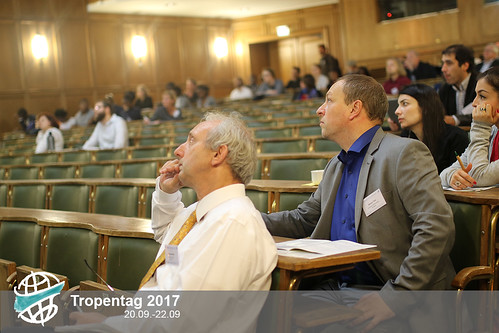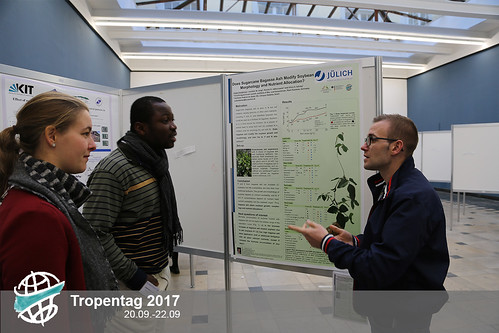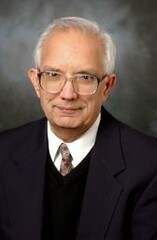soil
Young Scientists Work to Make a Healthier Soil
Thu, 09/21/2017 - 14:38 — mustamin.fadliAt the first oral presentation on soil and soil fertility today there were five young scientist presenting their work. I found two very interesting. Steffen Werner from the University of Bochum tried to answer if urban agriculture can contribute to food security by reducing nutrient losses. His two years work in Ghana used biochar and water irrigation to reduce nutrient losses. Urban and peri-urban agriculture is characterized by higher input and soil degradation. Excessive use of mineral fertilizer can lead to losses of nutrient through leaching.

However, his results still showed increased nutrient leaching, especially of N, P, Ca, Mg, and Na. He suggested more appropriate irrigation, because that proved effective in lowering leaching .
Irabella Thiemann from the University of Bonn tried to find out if flow paths in maize-paddy rice cropping system can be a hotspot for nutrient cycling. Maize-paddy rice cropping systems consume less water during the dry season. Changing systems from maize to rice led to desiccation cracks in the soil. Her research studied the role of this crack, where anaerobic conditions lead to methane emissions.
Soil Matter(s) - More Attention Please!
Wed, 09/20/2017 - 19:42 — schumacherlydiaIn the AULA, the poster session started with only a handful of patient Tropentag participants as the plenary session dragged on without end. After a few posters were presented, it got more and more crowded, to the point that standing two meters away from the speaker made it impossible to hear, much less understand. Conversations among the gaggle watching made it even harder. Camera and t-shirt made it clear I was there on business, and people made way so I could capture the the main content.

Based on the presented posters during the first session, soil and its components (it's a 4-dimensional object!) play a vital role in sustainable food production and therefore our future. The young researchers tried to find ways to use the many qualities of soil. Vitalij from the Juelich Institute had researched the effects of recycling sugarcane bagasse, a byproduct of industrial processing, when applied in soybean cultivation to increase nutrient availability and uptake.
Soils are like a bank account
Sat, 10/08/2011 - 12:10 — Minette Flora M... An Interview with Prof. Dr. Rattan Lal
“You cannot continue taking money out from the bank without putting it back. So improvement of soil on the basis of what has been taken out from harvesting must be replaced in a scientific manner,” stressed Prof. Dr. Rattan Lal, a distinguished university professor in soil physics and tropical soils from Ohio State University.
Either chemically or organically
“Applying manure or using bio-soil is the best option, but sometimes it is not strategically a very good option because manure requires a bulk amount. We require 10 ton/hectare of manure, which is the equivalent to100 kg of chemical fertilizer. So sometimes it is a question of logistics” he added. “A judicious combination of both organic and inorganic fertilizers is required because many times the organic matter is not adequate – it is called integrated nutrient management.”
Sub Saharan soils are marginalized
“I think Africa is the continent where the green revolution has by-passed because the soils in Sub Saharan Africa are really marginalized. They are depleted, denuded and degraded. Soil erosion and nutrient depletion of soil organic matter content have been very serious problems in Sub Saharan Africa. For sustainability, soil quality must be improved,” he concluded.
An Interview with Prof. Dr. Rattan Lal
“You cannot continue taking money out from the bank without putting it back. So improvement of soil on the basis of what has been taken out from harvesting must be replaced in a scientific manner,” stressed Prof. Dr. Rattan Lal, a distinguished university professor in soil physics and tropical soils from Ohio State University.
Either chemically or organically
“Applying manure or using bio-soil is the best option, but sometimes it is not strategically a very good option because manure requires a bulk amount. We require 10 ton/hectare of manure, which is the equivalent to100 kg of chemical fertilizer. So sometimes it is a question of logistics” he added. “A judicious combination of both organic and inorganic fertilizers is required because many times the organic matter is not adequate – it is called integrated nutrient management.”
Sub Saharan soils are marginalized
“I think Africa is the continent where the green revolution has by-passed because the soils in Sub Saharan Africa are really marginalized. They are depleted, denuded and degraded. Soil erosion and nutrient depletion of soil organic matter content have been very serious problems in Sub Saharan Africa. For sustainability, soil quality must be improved,” he concluded.




